Communication Studies Essay: Visual Analysis of Image A
VerifiedAdded on 2020/04/29
|10
|2797
|284
Essay
AI Summary
This essay provides a comprehensive visual analysis of image A within the field of communication studies, focusing on the Semiotics School of Communication. The analysis examines how the image explores female sexuality and its varying interpretations based on cultural and gendered perspectives. The methodology involves a detailed study of signs and symbols, including indexical signs, to understand the multilevel discourse presented. The essay highlights how the same image can be viewed differently by Western and Eastern cultures, reflecting diverse societal norms and values, particularly regarding the objectification of women and the evolving concepts of female independence. It discusses how the image might represent a sex object, a symbol of female self-sufficiency, or a challenge to patriarchal norms, depending on the viewer's social and cultural identity. The essay concludes by acknowledging the dilemmas faced by modern women, who navigate between personal freedom and societal expectations, and the importance of understanding the image's multifaceted meanings in the context of evolving gender dynamics.
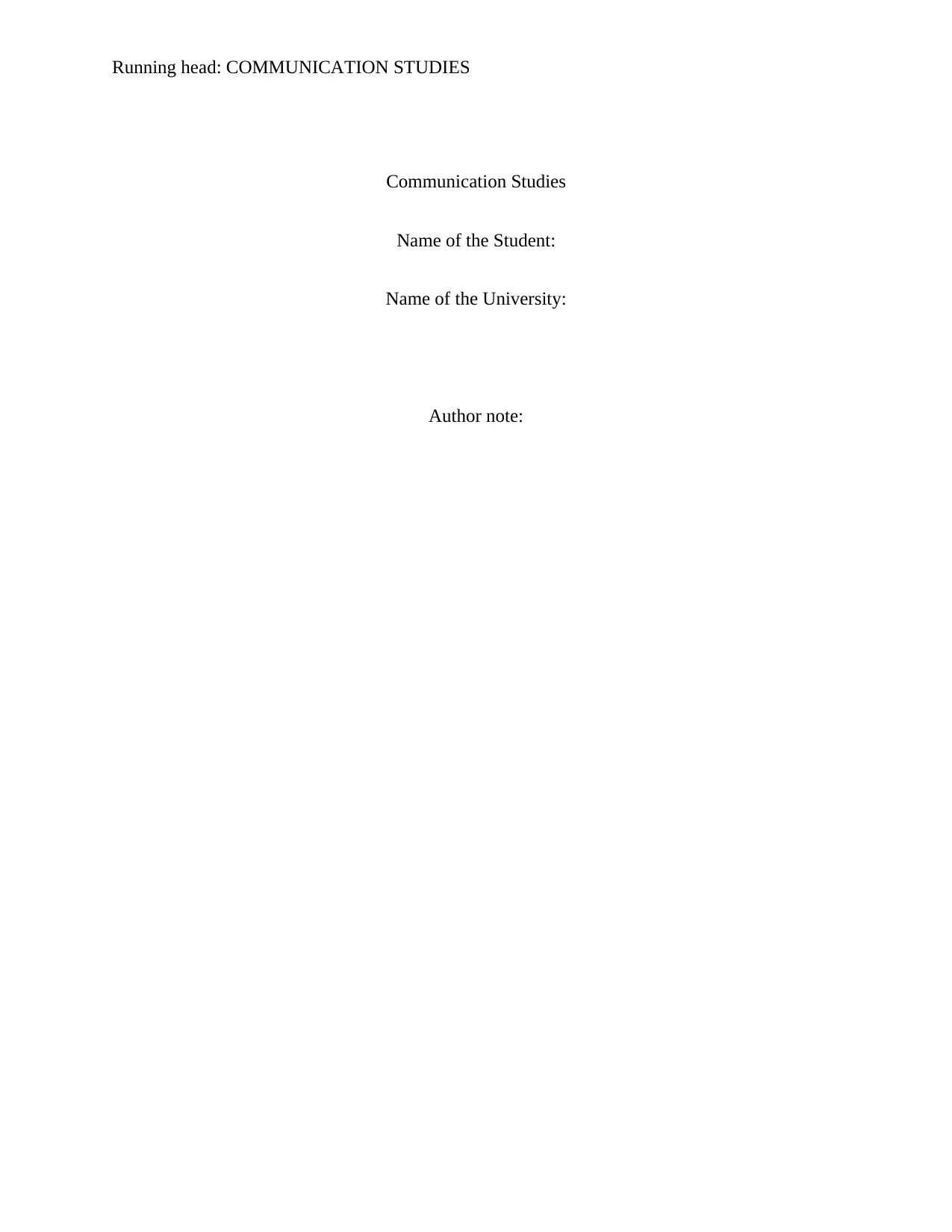
Running head: COMMUNICATION STUDIES
Communication Studies
Name of the Student:
Name of the University:
Author note:
Communication Studies
Name of the Student:
Name of the University:
Author note:
Secure Best Marks with AI Grader
Need help grading? Try our AI Grader for instant feedback on your assignments.
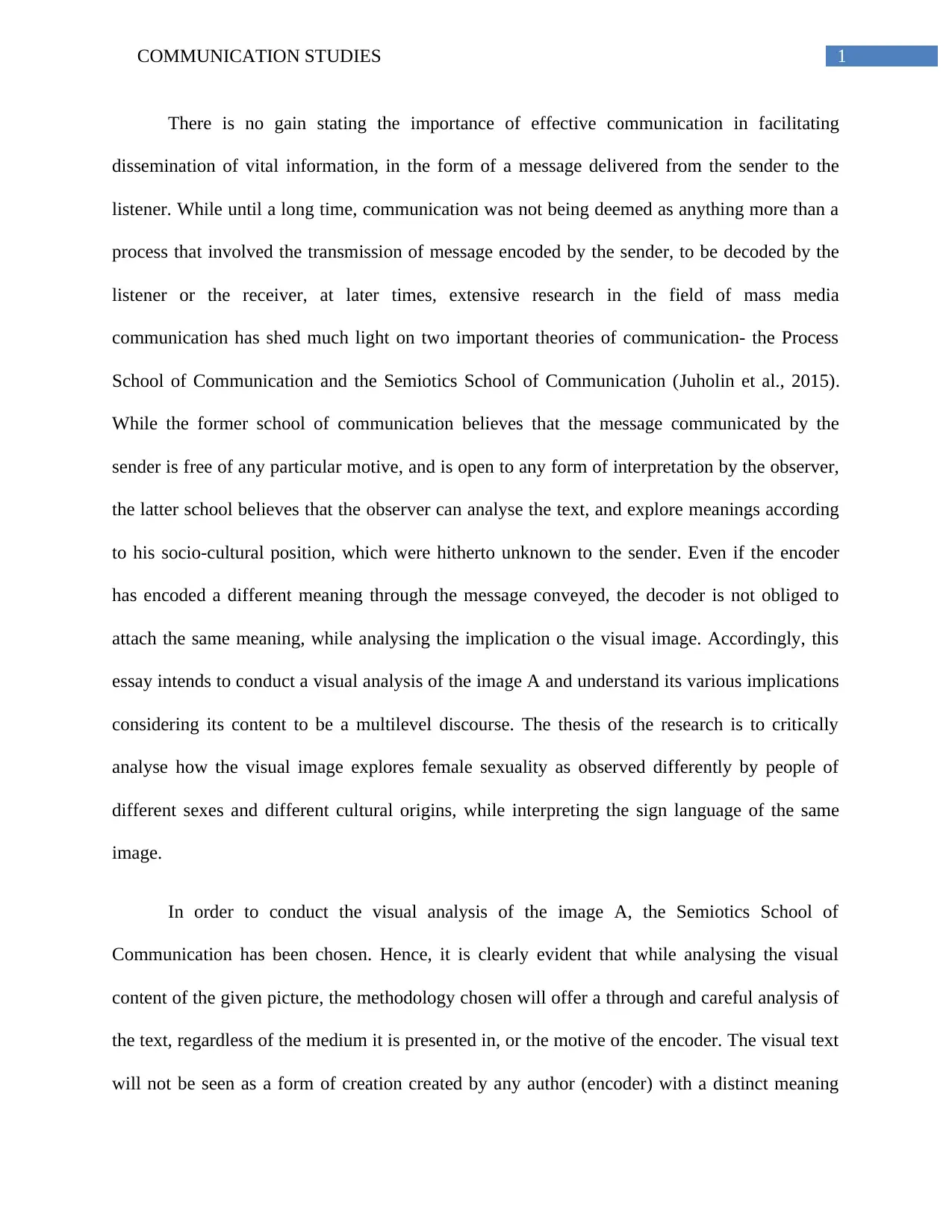
1COMMUNICATION STUDIES
There is no gain stating the importance of effective communication in facilitating
dissemination of vital information, in the form of a message delivered from the sender to the
listener. While until a long time, communication was not being deemed as anything more than a
process that involved the transmission of message encoded by the sender, to be decoded by the
listener or the receiver, at later times, extensive research in the field of mass media
communication has shed much light on two important theories of communication- the Process
School of Communication and the Semiotics School of Communication (Juholin et al., 2015).
While the former school of communication believes that the message communicated by the
sender is free of any particular motive, and is open to any form of interpretation by the observer,
the latter school believes that the observer can analyse the text, and explore meanings according
to his socio-cultural position, which were hitherto unknown to the sender. Even if the encoder
has encoded a different meaning through the message conveyed, the decoder is not obliged to
attach the same meaning, while analysing the implication o the visual image. Accordingly, this
essay intends to conduct a visual analysis of the image A and understand its various implications
considering its content to be a multilevel discourse. The thesis of the research is to critically
analyse how the visual image explores female sexuality as observed differently by people of
different sexes and different cultural origins, while interpreting the sign language of the same
image.
In order to conduct the visual analysis of the image A, the Semiotics School of
Communication has been chosen. Hence, it is clearly evident that while analysing the visual
content of the given picture, the methodology chosen will offer a through and careful analysis of
the text, regardless of the medium it is presented in, or the motive of the encoder. The visual text
will not be seen as a form of creation created by any author (encoder) with a distinct meaning
There is no gain stating the importance of effective communication in facilitating
dissemination of vital information, in the form of a message delivered from the sender to the
listener. While until a long time, communication was not being deemed as anything more than a
process that involved the transmission of message encoded by the sender, to be decoded by the
listener or the receiver, at later times, extensive research in the field of mass media
communication has shed much light on two important theories of communication- the Process
School of Communication and the Semiotics School of Communication (Juholin et al., 2015).
While the former school of communication believes that the message communicated by the
sender is free of any particular motive, and is open to any form of interpretation by the observer,
the latter school believes that the observer can analyse the text, and explore meanings according
to his socio-cultural position, which were hitherto unknown to the sender. Even if the encoder
has encoded a different meaning through the message conveyed, the decoder is not obliged to
attach the same meaning, while analysing the implication o the visual image. Accordingly, this
essay intends to conduct a visual analysis of the image A and understand its various implications
considering its content to be a multilevel discourse. The thesis of the research is to critically
analyse how the visual image explores female sexuality as observed differently by people of
different sexes and different cultural origins, while interpreting the sign language of the same
image.
In order to conduct the visual analysis of the image A, the Semiotics School of
Communication has been chosen. Hence, it is clearly evident that while analysing the visual
content of the given picture, the methodology chosen will offer a through and careful analysis of
the text, regardless of the medium it is presented in, or the motive of the encoder. The visual text
will not be seen as a form of creation created by any author (encoder) with a distinct meaning
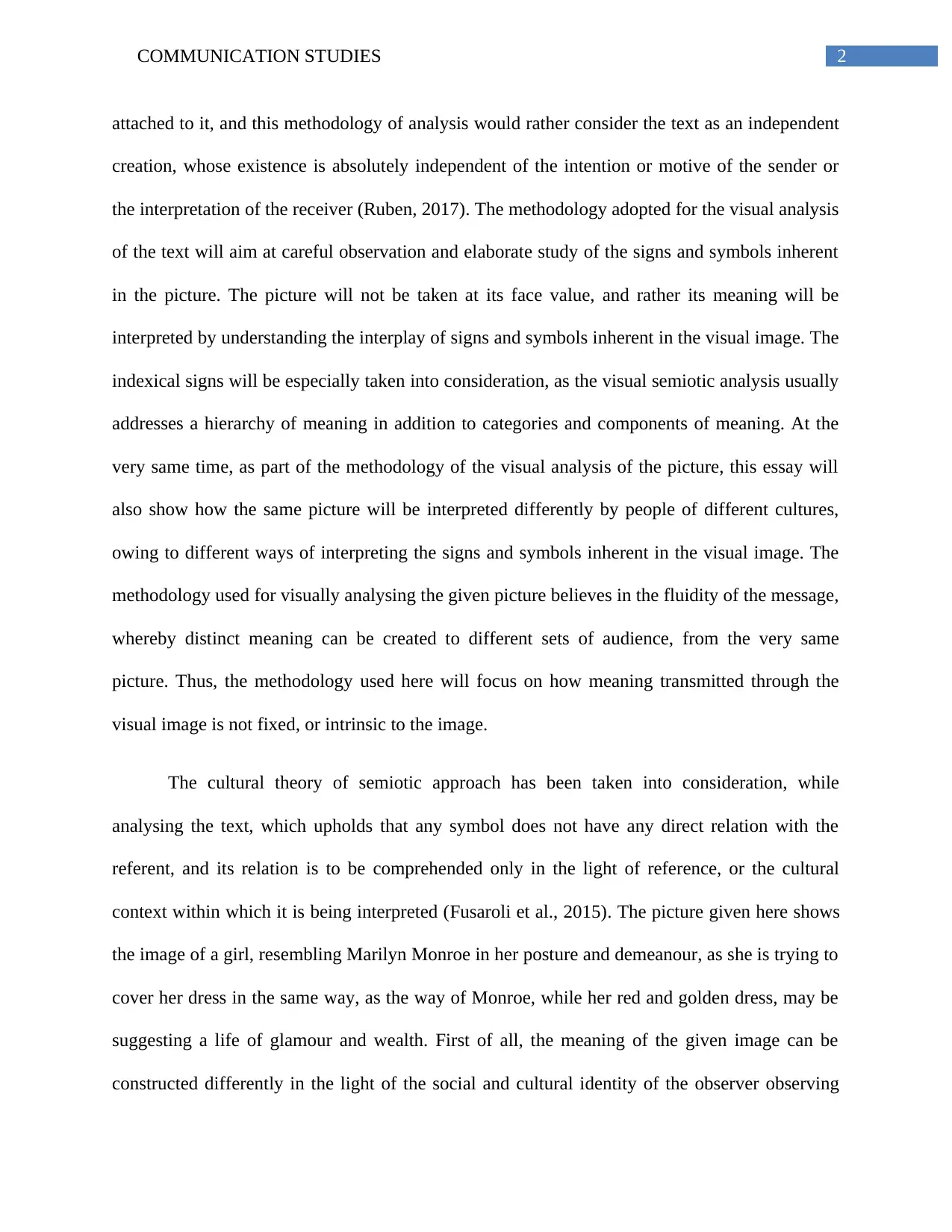
2COMMUNICATION STUDIES
attached to it, and this methodology of analysis would rather consider the text as an independent
creation, whose existence is absolutely independent of the intention or motive of the sender or
the interpretation of the receiver (Ruben, 2017). The methodology adopted for the visual analysis
of the text will aim at careful observation and elaborate study of the signs and symbols inherent
in the picture. The picture will not be taken at its face value, and rather its meaning will be
interpreted by understanding the interplay of signs and symbols inherent in the visual image. The
indexical signs will be especially taken into consideration, as the visual semiotic analysis usually
addresses a hierarchy of meaning in addition to categories and components of meaning. At the
very same time, as part of the methodology of the visual analysis of the picture, this essay will
also show how the same picture will be interpreted differently by people of different cultures,
owing to different ways of interpreting the signs and symbols inherent in the visual image. The
methodology used for visually analysing the given picture believes in the fluidity of the message,
whereby distinct meaning can be created to different sets of audience, from the very same
picture. Thus, the methodology used here will focus on how meaning transmitted through the
visual image is not fixed, or intrinsic to the image.
The cultural theory of semiotic approach has been taken into consideration, while
analysing the text, which upholds that any symbol does not have any direct relation with the
referent, and its relation is to be comprehended only in the light of reference, or the cultural
context within which it is being interpreted (Fusaroli et al., 2015). The picture given here shows
the image of a girl, resembling Marilyn Monroe in her posture and demeanour, as she is trying to
cover her dress in the same way, as the way of Monroe, while her red and golden dress, may be
suggesting a life of glamour and wealth. First of all, the meaning of the given image can be
constructed differently in the light of the social and cultural identity of the observer observing
attached to it, and this methodology of analysis would rather consider the text as an independent
creation, whose existence is absolutely independent of the intention or motive of the sender or
the interpretation of the receiver (Ruben, 2017). The methodology adopted for the visual analysis
of the text will aim at careful observation and elaborate study of the signs and symbols inherent
in the picture. The picture will not be taken at its face value, and rather its meaning will be
interpreted by understanding the interplay of signs and symbols inherent in the visual image. The
indexical signs will be especially taken into consideration, as the visual semiotic analysis usually
addresses a hierarchy of meaning in addition to categories and components of meaning. At the
very same time, as part of the methodology of the visual analysis of the picture, this essay will
also show how the same picture will be interpreted differently by people of different cultures,
owing to different ways of interpreting the signs and symbols inherent in the visual image. The
methodology used for visually analysing the given picture believes in the fluidity of the message,
whereby distinct meaning can be created to different sets of audience, from the very same
picture. Thus, the methodology used here will focus on how meaning transmitted through the
visual image is not fixed, or intrinsic to the image.
The cultural theory of semiotic approach has been taken into consideration, while
analysing the text, which upholds that any symbol does not have any direct relation with the
referent, and its relation is to be comprehended only in the light of reference, or the cultural
context within which it is being interpreted (Fusaroli et al., 2015). The picture given here shows
the image of a girl, resembling Marilyn Monroe in her posture and demeanour, as she is trying to
cover her dress in the same way, as the way of Monroe, while her red and golden dress, may be
suggesting a life of glamour and wealth. First of all, the meaning of the given image can be
constructed differently in the light of the social and cultural identity of the observer observing
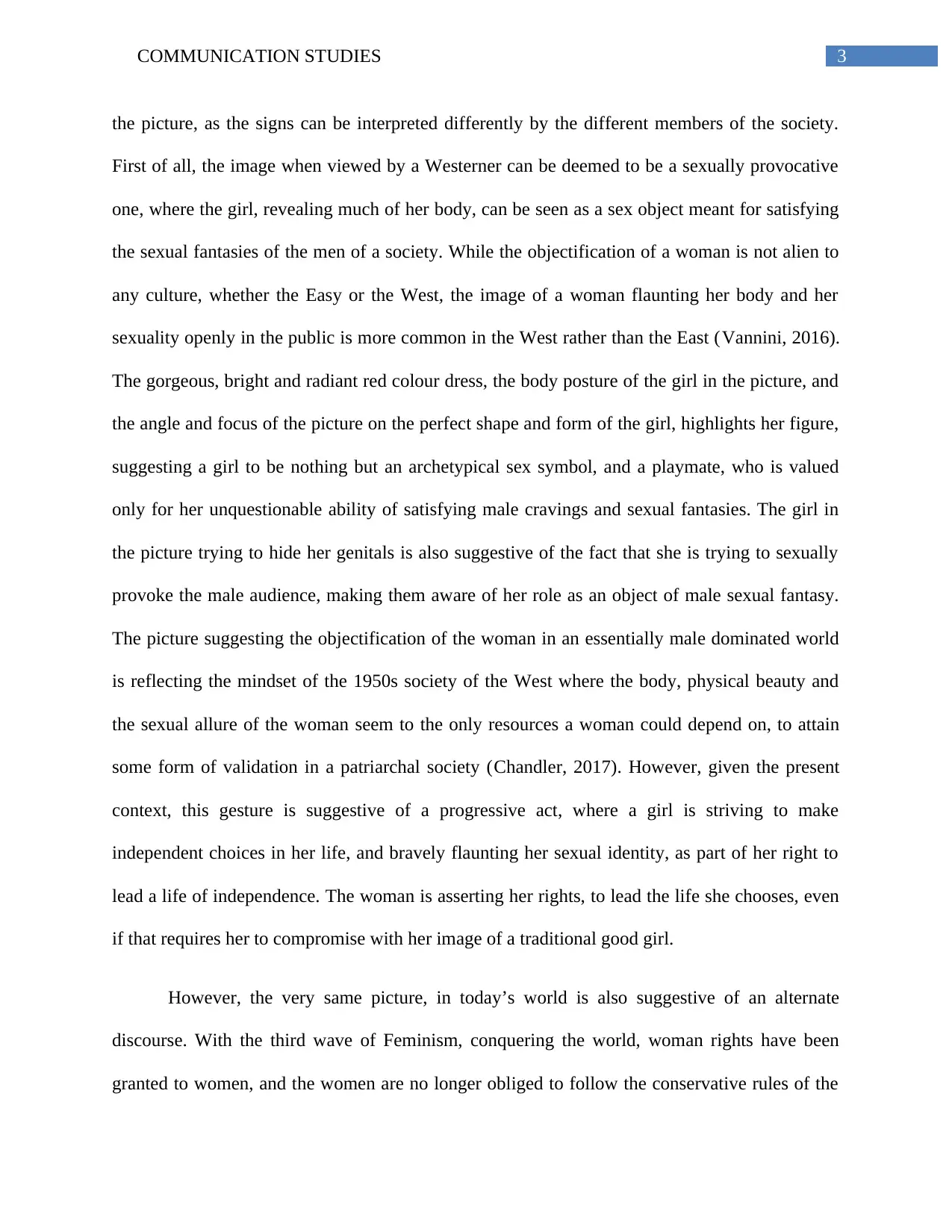
3COMMUNICATION STUDIES
the picture, as the signs can be interpreted differently by the different members of the society.
First of all, the image when viewed by a Westerner can be deemed to be a sexually provocative
one, where the girl, revealing much of her body, can be seen as a sex object meant for satisfying
the sexual fantasies of the men of a society. While the objectification of a woman is not alien to
any culture, whether the Easy or the West, the image of a woman flaunting her body and her
sexuality openly in the public is more common in the West rather than the East (Vannini, 2016).
The gorgeous, bright and radiant red colour dress, the body posture of the girl in the picture, and
the angle and focus of the picture on the perfect shape and form of the girl, highlights her figure,
suggesting a girl to be nothing but an archetypical sex symbol, and a playmate, who is valued
only for her unquestionable ability of satisfying male cravings and sexual fantasies. The girl in
the picture trying to hide her genitals is also suggestive of the fact that she is trying to sexually
provoke the male audience, making them aware of her role as an object of male sexual fantasy.
The picture suggesting the objectification of the woman in an essentially male dominated world
is reflecting the mindset of the 1950s society of the West where the body, physical beauty and
the sexual allure of the woman seem to the only resources a woman could depend on, to attain
some form of validation in a patriarchal society (Chandler, 2017). However, given the present
context, this gesture is suggestive of a progressive act, where a girl is striving to make
independent choices in her life, and bravely flaunting her sexual identity, as part of her right to
lead a life of independence. The woman is asserting her rights, to lead the life she chooses, even
if that requires her to compromise with her image of a traditional good girl.
However, the very same picture, in today’s world is also suggestive of an alternate
discourse. With the third wave of Feminism, conquering the world, woman rights have been
granted to women, and the women are no longer obliged to follow the conservative rules of the
the picture, as the signs can be interpreted differently by the different members of the society.
First of all, the image when viewed by a Westerner can be deemed to be a sexually provocative
one, where the girl, revealing much of her body, can be seen as a sex object meant for satisfying
the sexual fantasies of the men of a society. While the objectification of a woman is not alien to
any culture, whether the Easy or the West, the image of a woman flaunting her body and her
sexuality openly in the public is more common in the West rather than the East (Vannini, 2016).
The gorgeous, bright and radiant red colour dress, the body posture of the girl in the picture, and
the angle and focus of the picture on the perfect shape and form of the girl, highlights her figure,
suggesting a girl to be nothing but an archetypical sex symbol, and a playmate, who is valued
only for her unquestionable ability of satisfying male cravings and sexual fantasies. The girl in
the picture trying to hide her genitals is also suggestive of the fact that she is trying to sexually
provoke the male audience, making them aware of her role as an object of male sexual fantasy.
The picture suggesting the objectification of the woman in an essentially male dominated world
is reflecting the mindset of the 1950s society of the West where the body, physical beauty and
the sexual allure of the woman seem to the only resources a woman could depend on, to attain
some form of validation in a patriarchal society (Chandler, 2017). However, given the present
context, this gesture is suggestive of a progressive act, where a girl is striving to make
independent choices in her life, and bravely flaunting her sexual identity, as part of her right to
lead a life of independence. The woman is asserting her rights, to lead the life she chooses, even
if that requires her to compromise with her image of a traditional good girl.
However, the very same picture, in today’s world is also suggestive of an alternate
discourse. With the third wave of Feminism, conquering the world, woman rights have been
granted to women, and the women are no longer obliged to follow the conservative rules of the
Secure Best Marks with AI Grader
Need help grading? Try our AI Grader for instant feedback on your assignments.
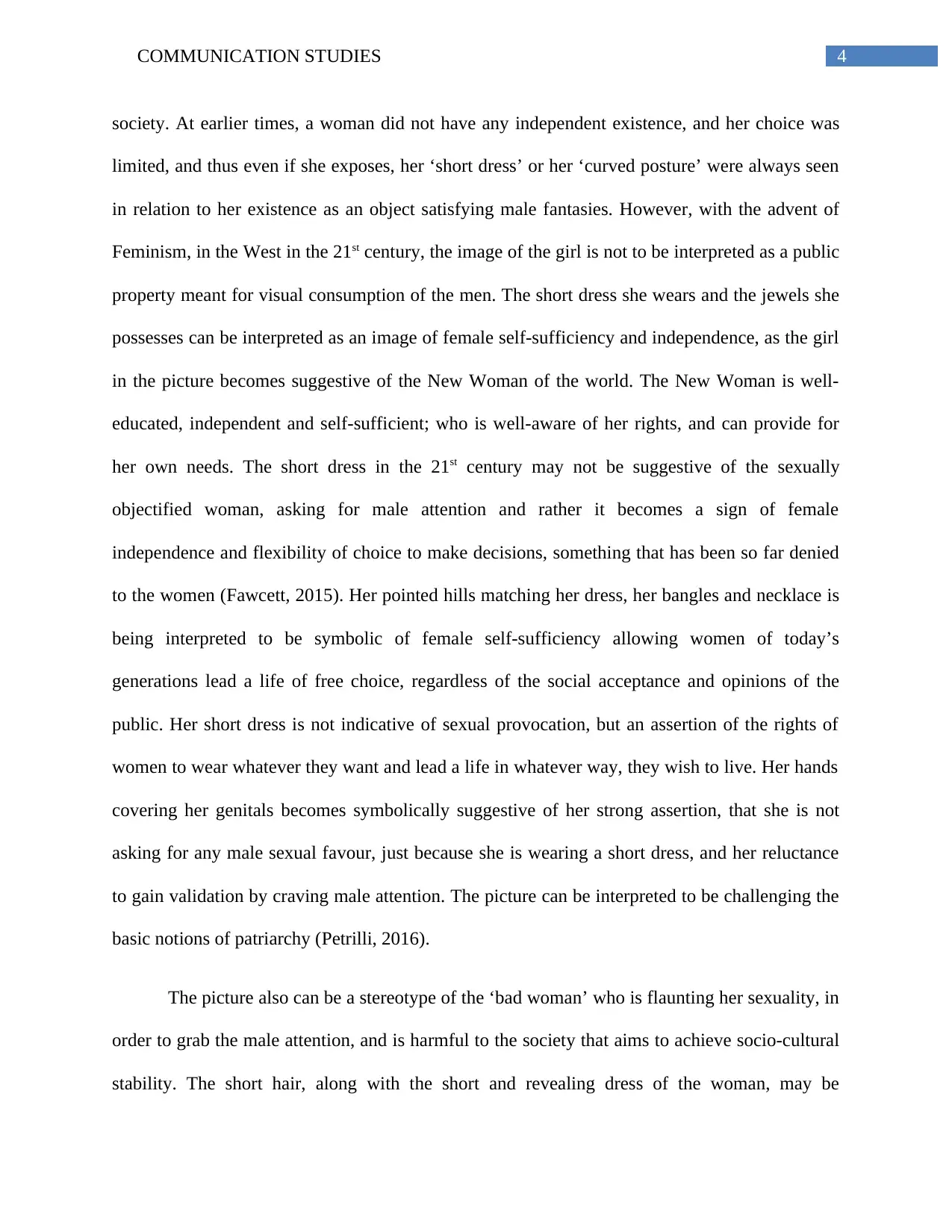
4COMMUNICATION STUDIES
society. At earlier times, a woman did not have any independent existence, and her choice was
limited, and thus even if she exposes, her ‘short dress’ or her ‘curved posture’ were always seen
in relation to her existence as an object satisfying male fantasies. However, with the advent of
Feminism, in the West in the 21st century, the image of the girl is not to be interpreted as a public
property meant for visual consumption of the men. The short dress she wears and the jewels she
possesses can be interpreted as an image of female self-sufficiency and independence, as the girl
in the picture becomes suggestive of the New Woman of the world. The New Woman is well-
educated, independent and self-sufficient; who is well-aware of her rights, and can provide for
her own needs. The short dress in the 21st century may not be suggestive of the sexually
objectified woman, asking for male attention and rather it becomes a sign of female
independence and flexibility of choice to make decisions, something that has been so far denied
to the women (Fawcett, 2015). Her pointed hills matching her dress, her bangles and necklace is
being interpreted to be symbolic of female self-sufficiency allowing women of today’s
generations lead a life of free choice, regardless of the social acceptance and opinions of the
public. Her short dress is not indicative of sexual provocation, but an assertion of the rights of
women to wear whatever they want and lead a life in whatever way, they wish to live. Her hands
covering her genitals becomes symbolically suggestive of her strong assertion, that she is not
asking for any male sexual favour, just because she is wearing a short dress, and her reluctance
to gain validation by craving male attention. The picture can be interpreted to be challenging the
basic notions of patriarchy (Petrilli, 2016).
The picture also can be a stereotype of the ‘bad woman’ who is flaunting her sexuality, in
order to grab the male attention, and is harmful to the society that aims to achieve socio-cultural
stability. The short hair, along with the short and revealing dress of the woman, may be
society. At earlier times, a woman did not have any independent existence, and her choice was
limited, and thus even if she exposes, her ‘short dress’ or her ‘curved posture’ were always seen
in relation to her existence as an object satisfying male fantasies. However, with the advent of
Feminism, in the West in the 21st century, the image of the girl is not to be interpreted as a public
property meant for visual consumption of the men. The short dress she wears and the jewels she
possesses can be interpreted as an image of female self-sufficiency and independence, as the girl
in the picture becomes suggestive of the New Woman of the world. The New Woman is well-
educated, independent and self-sufficient; who is well-aware of her rights, and can provide for
her own needs. The short dress in the 21st century may not be suggestive of the sexually
objectified woman, asking for male attention and rather it becomes a sign of female
independence and flexibility of choice to make decisions, something that has been so far denied
to the women (Fawcett, 2015). Her pointed hills matching her dress, her bangles and necklace is
being interpreted to be symbolic of female self-sufficiency allowing women of today’s
generations lead a life of free choice, regardless of the social acceptance and opinions of the
public. Her short dress is not indicative of sexual provocation, but an assertion of the rights of
women to wear whatever they want and lead a life in whatever way, they wish to live. Her hands
covering her genitals becomes symbolically suggestive of her strong assertion, that she is not
asking for any male sexual favour, just because she is wearing a short dress, and her reluctance
to gain validation by craving male attention. The picture can be interpreted to be challenging the
basic notions of patriarchy (Petrilli, 2016).
The picture also can be a stereotype of the ‘bad woman’ who is flaunting her sexuality, in
order to grab the male attention, and is harmful to the society that aims to achieve socio-cultural
stability. The short hair, along with the short and revealing dress of the woman, may be
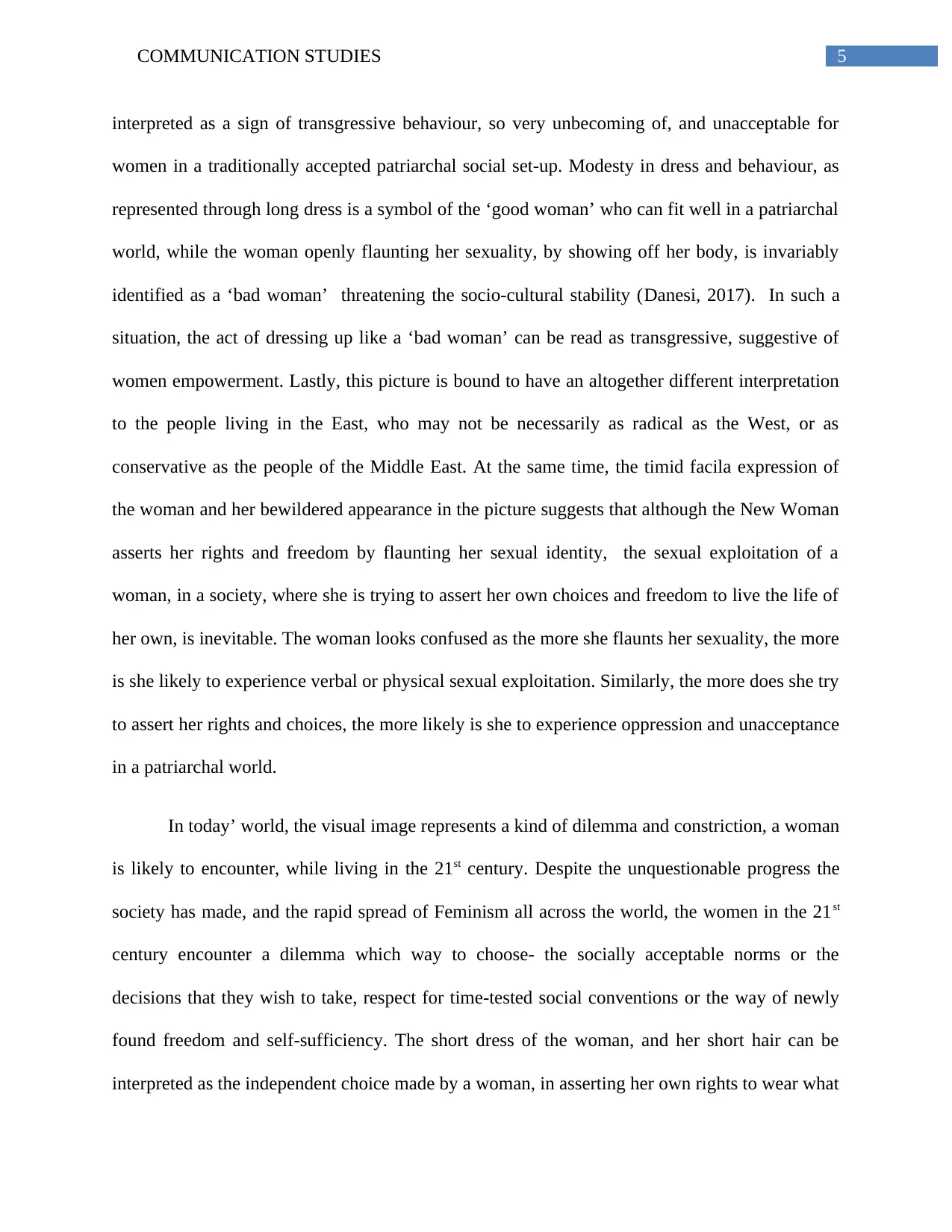
5COMMUNICATION STUDIES
interpreted as a sign of transgressive behaviour, so very unbecoming of, and unacceptable for
women in a traditionally accepted patriarchal social set-up. Modesty in dress and behaviour, as
represented through long dress is a symbol of the ‘good woman’ who can fit well in a patriarchal
world, while the woman openly flaunting her sexuality, by showing off her body, is invariably
identified as a ‘bad woman’ threatening the socio-cultural stability (Danesi, 2017). In such a
situation, the act of dressing up like a ‘bad woman’ can be read as transgressive, suggestive of
women empowerment. Lastly, this picture is bound to have an altogether different interpretation
to the people living in the East, who may not be necessarily as radical as the West, or as
conservative as the people of the Middle East. At the same time, the timid facila expression of
the woman and her bewildered appearance in the picture suggests that although the New Woman
asserts her rights and freedom by flaunting her sexual identity, the sexual exploitation of a
woman, in a society, where she is trying to assert her own choices and freedom to live the life of
her own, is inevitable. The woman looks confused as the more she flaunts her sexuality, the more
is she likely to experience verbal or physical sexual exploitation. Similarly, the more does she try
to assert her rights and choices, the more likely is she to experience oppression and unacceptance
in a patriarchal world.
In today’ world, the visual image represents a kind of dilemma and constriction, a woman
is likely to encounter, while living in the 21st century. Despite the unquestionable progress the
society has made, and the rapid spread of Feminism all across the world, the women in the 21st
century encounter a dilemma which way to choose- the socially acceptable norms or the
decisions that they wish to take, respect for time-tested social conventions or the way of newly
found freedom and self-sufficiency. The short dress of the woman, and her short hair can be
interpreted as the independent choice made by a woman, in asserting her own rights to wear what
interpreted as a sign of transgressive behaviour, so very unbecoming of, and unacceptable for
women in a traditionally accepted patriarchal social set-up. Modesty in dress and behaviour, as
represented through long dress is a symbol of the ‘good woman’ who can fit well in a patriarchal
world, while the woman openly flaunting her sexuality, by showing off her body, is invariably
identified as a ‘bad woman’ threatening the socio-cultural stability (Danesi, 2017). In such a
situation, the act of dressing up like a ‘bad woman’ can be read as transgressive, suggestive of
women empowerment. Lastly, this picture is bound to have an altogether different interpretation
to the people living in the East, who may not be necessarily as radical as the West, or as
conservative as the people of the Middle East. At the same time, the timid facila expression of
the woman and her bewildered appearance in the picture suggests that although the New Woman
asserts her rights and freedom by flaunting her sexual identity, the sexual exploitation of a
woman, in a society, where she is trying to assert her own choices and freedom to live the life of
her own, is inevitable. The woman looks confused as the more she flaunts her sexuality, the more
is she likely to experience verbal or physical sexual exploitation. Similarly, the more does she try
to assert her rights and choices, the more likely is she to experience oppression and unacceptance
in a patriarchal world.
In today’ world, the visual image represents a kind of dilemma and constriction, a woman
is likely to encounter, while living in the 21st century. Despite the unquestionable progress the
society has made, and the rapid spread of Feminism all across the world, the women in the 21st
century encounter a dilemma which way to choose- the socially acceptable norms or the
decisions that they wish to take, respect for time-tested social conventions or the way of newly
found freedom and self-sufficiency. The short dress of the woman, and her short hair can be
interpreted as the independent choice made by a woman, in asserting her own rights to wear what
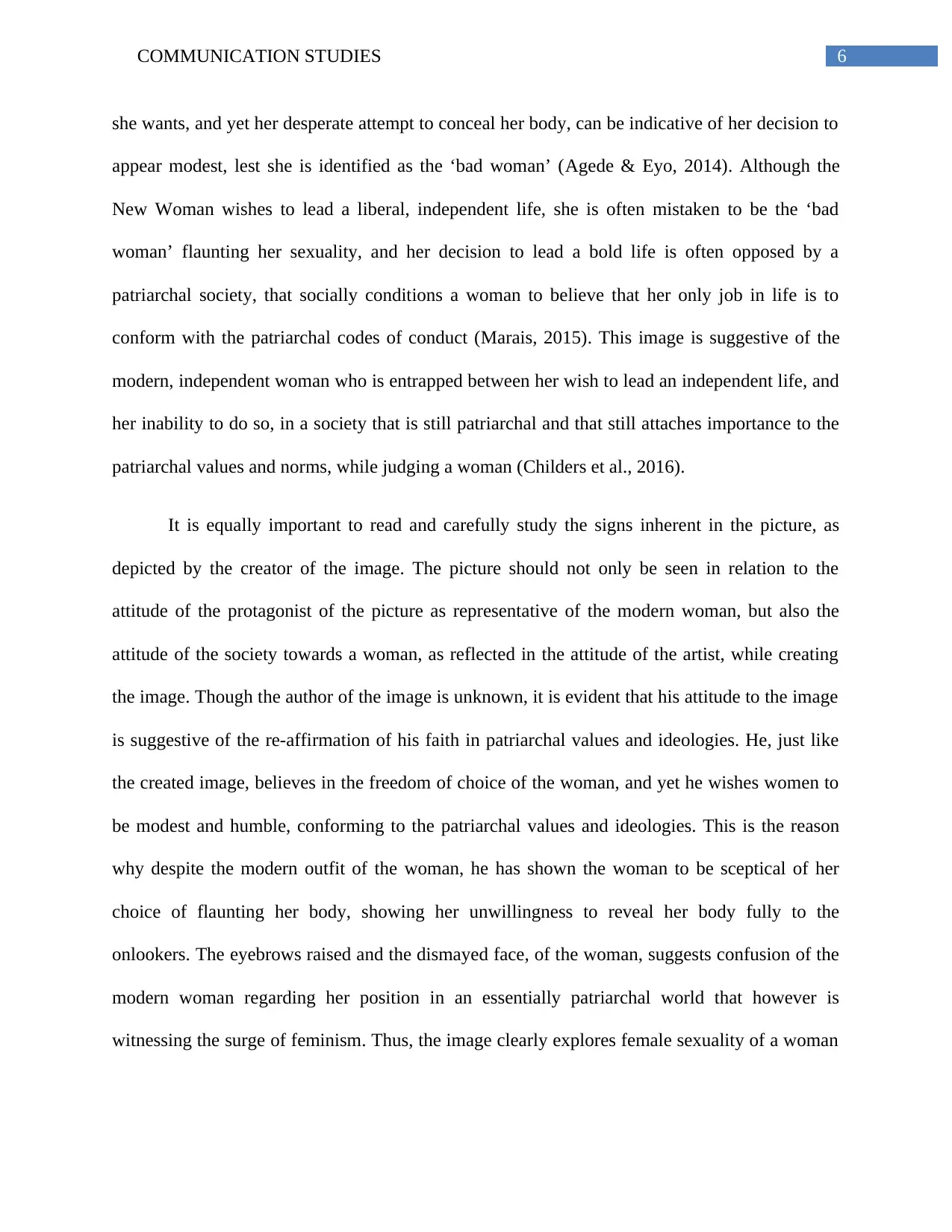
6COMMUNICATION STUDIES
she wants, and yet her desperate attempt to conceal her body, can be indicative of her decision to
appear modest, lest she is identified as the ‘bad woman’ (Agede & Eyo, 2014). Although the
New Woman wishes to lead a liberal, independent life, she is often mistaken to be the ‘bad
woman’ flaunting her sexuality, and her decision to lead a bold life is often opposed by a
patriarchal society, that socially conditions a woman to believe that her only job in life is to
conform with the patriarchal codes of conduct (Marais, 2015). This image is suggestive of the
modern, independent woman who is entrapped between her wish to lead an independent life, and
her inability to do so, in a society that is still patriarchal and that still attaches importance to the
patriarchal values and norms, while judging a woman (Childers et al., 2016).
It is equally important to read and carefully study the signs inherent in the picture, as
depicted by the creator of the image. The picture should not only be seen in relation to the
attitude of the protagonist of the picture as representative of the modern woman, but also the
attitude of the society towards a woman, as reflected in the attitude of the artist, while creating
the image. Though the author of the image is unknown, it is evident that his attitude to the image
is suggestive of the re-affirmation of his faith in patriarchal values and ideologies. He, just like
the created image, believes in the freedom of choice of the woman, and yet he wishes women to
be modest and humble, conforming to the patriarchal values and ideologies. This is the reason
why despite the modern outfit of the woman, he has shown the woman to be sceptical of her
choice of flaunting her body, showing her unwillingness to reveal her body fully to the
onlookers. The eyebrows raised and the dismayed face, of the woman, suggests confusion of the
modern woman regarding her position in an essentially patriarchal world that however is
witnessing the surge of feminism. Thus, the image clearly explores female sexuality of a woman
she wants, and yet her desperate attempt to conceal her body, can be indicative of her decision to
appear modest, lest she is identified as the ‘bad woman’ (Agede & Eyo, 2014). Although the
New Woman wishes to lead a liberal, independent life, she is often mistaken to be the ‘bad
woman’ flaunting her sexuality, and her decision to lead a bold life is often opposed by a
patriarchal society, that socially conditions a woman to believe that her only job in life is to
conform with the patriarchal codes of conduct (Marais, 2015). This image is suggestive of the
modern, independent woman who is entrapped between her wish to lead an independent life, and
her inability to do so, in a society that is still patriarchal and that still attaches importance to the
patriarchal values and norms, while judging a woman (Childers et al., 2016).
It is equally important to read and carefully study the signs inherent in the picture, as
depicted by the creator of the image. The picture should not only be seen in relation to the
attitude of the protagonist of the picture as representative of the modern woman, but also the
attitude of the society towards a woman, as reflected in the attitude of the artist, while creating
the image. Though the author of the image is unknown, it is evident that his attitude to the image
is suggestive of the re-affirmation of his faith in patriarchal values and ideologies. He, just like
the created image, believes in the freedom of choice of the woman, and yet he wishes women to
be modest and humble, conforming to the patriarchal values and ideologies. This is the reason
why despite the modern outfit of the woman, he has shown the woman to be sceptical of her
choice of flaunting her body, showing her unwillingness to reveal her body fully to the
onlookers. The eyebrows raised and the dismayed face, of the woman, suggests confusion of the
modern woman regarding her position in an essentially patriarchal world that however is
witnessing the surge of feminism. Thus, the image clearly explores female sexuality of a woman
Paraphrase This Document
Need a fresh take? Get an instant paraphrase of this document with our AI Paraphraser

7COMMUNICATION STUDIES
in a patriarchal world, where the assertion of woman rights is seen both as a progressive as well
as a transgressive act, with the woman vacillating as to which path to choose.
in a patriarchal world, where the assertion of woman rights is seen both as a progressive as well
as a transgressive act, with the woman vacillating as to which path to choose.
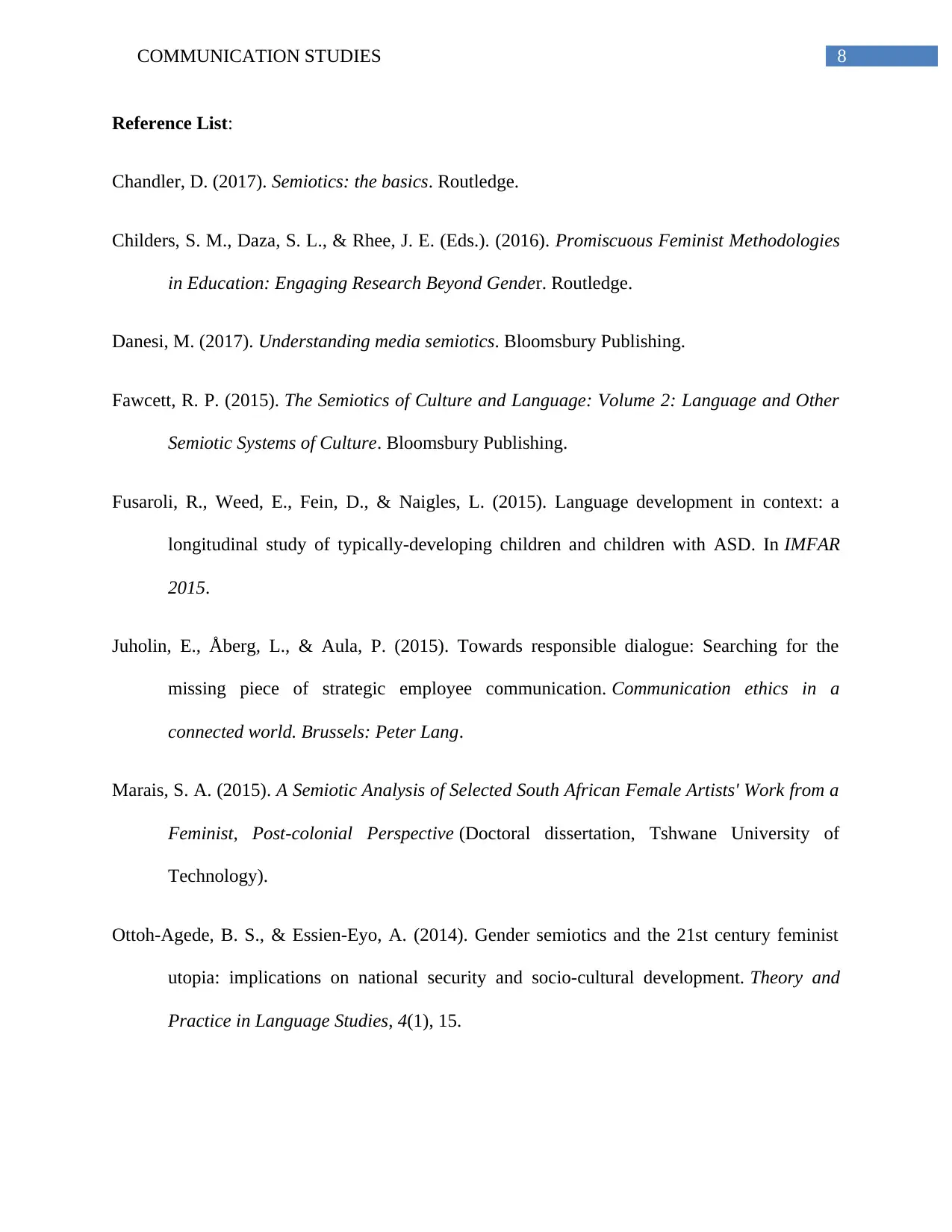
8COMMUNICATION STUDIES
Reference List:
Chandler, D. (2017). Semiotics: the basics. Routledge.
Childers, S. M., Daza, S. L., & Rhee, J. E. (Eds.). (2016). Promiscuous Feminist Methodologies
in Education: Engaging Research Beyond Gender. Routledge.
Danesi, M. (2017). Understanding media semiotics. Bloomsbury Publishing.
Fawcett, R. P. (2015). The Semiotics of Culture and Language: Volume 2: Language and Other
Semiotic Systems of Culture. Bloomsbury Publishing.
Fusaroli, R., Weed, E., Fein, D., & Naigles, L. (2015). Language development in context: a
longitudinal study of typically-developing children and children with ASD. In IMFAR
2015.
Juholin, E., Åberg, L., & Aula, P. (2015). Towards responsible dialogue: Searching for the
missing piece of strategic employee communication. Communication ethics in a
connected world. Brussels: Peter Lang.
Marais, S. A. (2015). A Semiotic Analysis of Selected South African Female Artists' Work from a
Feminist, Post-colonial Perspective (Doctoral dissertation, Tshwane University of
Technology).
Ottoh-Agede, B. S., & Essien-Eyo, A. (2014). Gender semiotics and the 21st century feminist
utopia: implications on national security and socio-cultural development. Theory and
Practice in Language Studies, 4(1), 15.
Reference List:
Chandler, D. (2017). Semiotics: the basics. Routledge.
Childers, S. M., Daza, S. L., & Rhee, J. E. (Eds.). (2016). Promiscuous Feminist Methodologies
in Education: Engaging Research Beyond Gender. Routledge.
Danesi, M. (2017). Understanding media semiotics. Bloomsbury Publishing.
Fawcett, R. P. (2015). The Semiotics of Culture and Language: Volume 2: Language and Other
Semiotic Systems of Culture. Bloomsbury Publishing.
Fusaroli, R., Weed, E., Fein, D., & Naigles, L. (2015). Language development in context: a
longitudinal study of typically-developing children and children with ASD. In IMFAR
2015.
Juholin, E., Åberg, L., & Aula, P. (2015). Towards responsible dialogue: Searching for the
missing piece of strategic employee communication. Communication ethics in a
connected world. Brussels: Peter Lang.
Marais, S. A. (2015). A Semiotic Analysis of Selected South African Female Artists' Work from a
Feminist, Post-colonial Perspective (Doctoral dissertation, Tshwane University of
Technology).
Ottoh-Agede, B. S., & Essien-Eyo, A. (2014). Gender semiotics and the 21st century feminist
utopia: implications on national security and socio-cultural development. Theory and
Practice in Language Studies, 4(1), 15.
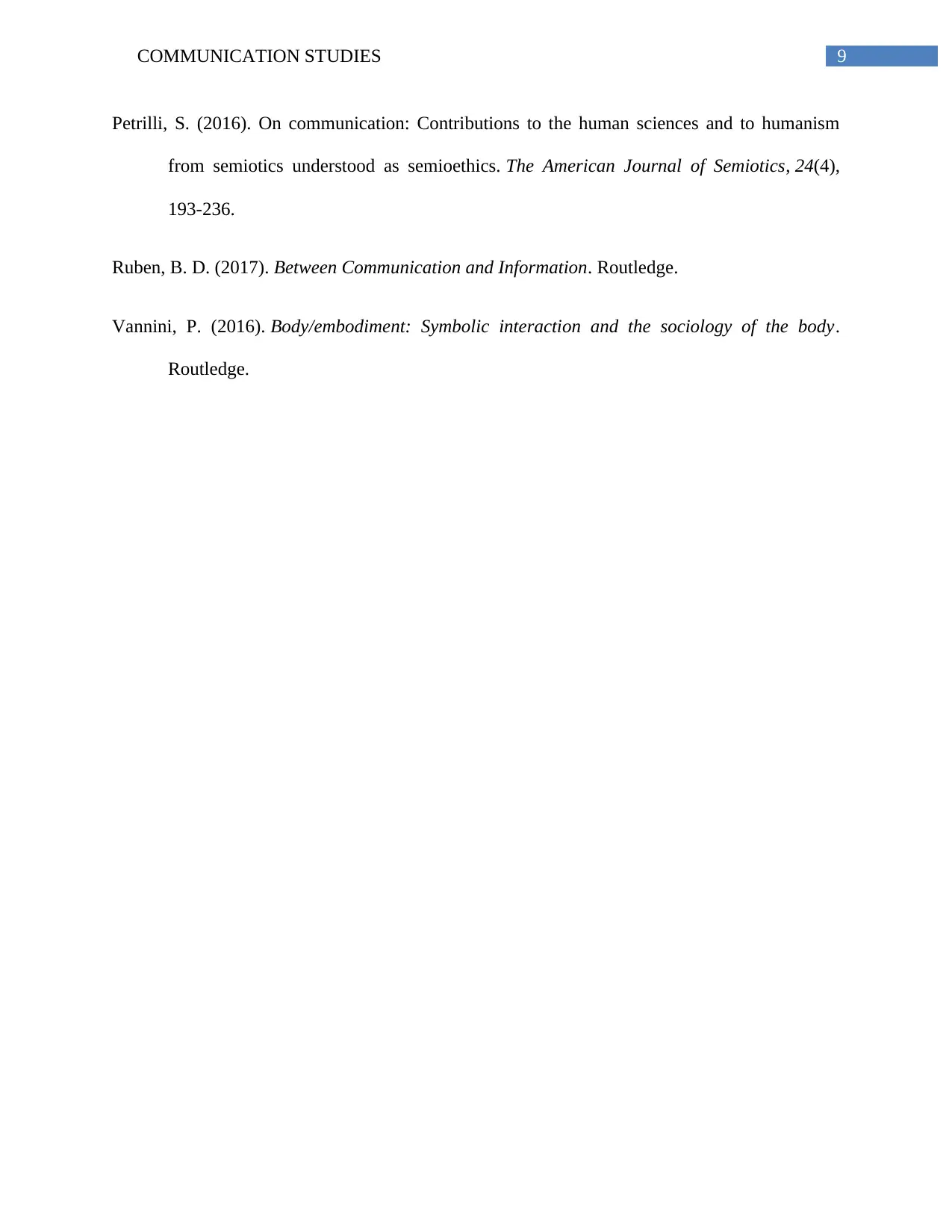
9COMMUNICATION STUDIES
Petrilli, S. (2016). On communication: Contributions to the human sciences and to humanism
from semiotics understood as semioethics. The American Journal of Semiotics, 24(4),
193-236.
Ruben, B. D. (2017). Between Communication and Information. Routledge.
Vannini, P. (2016). Body/embodiment: Symbolic interaction and the sociology of the body.
Routledge.
Petrilli, S. (2016). On communication: Contributions to the human sciences and to humanism
from semiotics understood as semioethics. The American Journal of Semiotics, 24(4),
193-236.
Ruben, B. D. (2017). Between Communication and Information. Routledge.
Vannini, P. (2016). Body/embodiment: Symbolic interaction and the sociology of the body.
Routledge.
1 out of 10
Related Documents
Your All-in-One AI-Powered Toolkit for Academic Success.
+13062052269
info@desklib.com
Available 24*7 on WhatsApp / Email
![[object Object]](/_next/static/media/star-bottom.7253800d.svg)
Unlock your academic potential
© 2024 | Zucol Services PVT LTD | All rights reserved.




